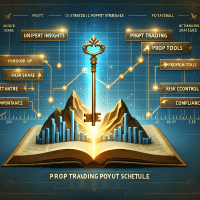Proven Prop Trading Payout Strategies for Advanced Traders
In today’s competitive prop trading landscape, understanding the intricacies of prop trading payout is critical for achieving sustainable profitability. This article guides experienced traders, quants, risk managers, and aspiring professionals through strategic payout structures, advanced backtesting insights, and actionable case studies.
Prop trading firms have evolved from traditional setups to highly data-driven operations. They now leverage advanced automated backtesting and algorithmic execution to fine-tune strategies that boost profit splits and minimize risk. This article unpacks these modern techniques, giving you the expert guidance needed to elevate your performance.
Figure 1: A screenshot of a backtesting report from TradingView demonstrating key performance metrics.
Understanding Prop Trading Payout Structures
Prop trading payout is more than just a split of profits. It involves complex arrangements that balance risk and reward between firms and traders. Key factors include:
- Profit Split Models: Standards typically range from 50/50 to 80/20 in favor of the trader, depending on performance benchmarks.
- Risk Management Ratios: Indicators such as Sharpe Ratio targets, maximum drawdown, and profit factor play crucial roles in determining payouts.
- Regulatory Considerations: Rules such as MiFID II, ESMA, and NFA guidelines influence payout structures to ensure transparency and fairness.
Advanced Backtesting for Prop Trading Strategies
Backtesting remains the cornerstone of developing effective prop trading strategies. Today’s advanced backtesting tools provide key features like:
- Automated Parameter Optimization: Tools like TradingView and QuantConnect allow for automated adjustments that reduce manual data snooping.
- Walk-Forward Optimization: By constantly updating models, traders reduce the risk of overfitting to historical data.
- Out-of-Sample Testing: This ensures strategies perform well in live conditions, not just under historical scenarios.
Common Backtesting Pitfalls and Mitigation
One of the chief challenges in backtesting is avoiding biases such as:
- Overfitting: Excessively tailoring strategies to past data can lead to disappointing forward performance. Use cross-validation and regular recalibration techniques.
- Survivorship Bias: Including only successful stocks may skew results. A robust dataset including delisted and failed instruments is necessary.
- Look-Ahead Bias: Ensure the testing process does not use future data inadvertently in algorithm development.
Comparative Analysis of Automated Backtesting Tools
To maximize payouts, the right backtesting tool is critical. Below is a detailed comparison of three widely-recognized platforms:
| Tool | Backtesting Features | Data Quality & Availability | Integration Capabilities | Pricing / Free Options | Use Cases |
|---|---|---|---|---|---|
| TradingView | Vectorized backtesting, automated optimizations, commission & slippage simulation | Extensive historical data across asset classes with real-time feeds | API access, broker integration, community scripts | Free with premium tiers available | Ideal for both prop firms and retail traders |
| MetaTrader 5 | Event-driven backtesting, strategy optimization, robust reporting | Depth in forex and CFD data, real-time pricing | Expert advisors (EAs), direct broker connectivity | Free demo, competitive brokerage fees | Suitable for high frequency and algorithmic strategies |
| NinjaTrader | Highly customizable backtesting, stress testing, scenario analysis | Rich historical and tick data, multi-asset support | Third-party add-ons, robust API integrations | Free with simulation mode; licensing packages available | Best for advanced team-based analysis in a prop firm setting |
Integration with Prop Trading Frameworks
The selected platforms not only automate backtesting but also streamline the transition from analysis to live trading. For example, NinjaTrader offers robust team collaboration features that allow risk managers and quants to monitor real-time performance, while TradingView provides easy integration with brokers and dashboards for shared analytics. This is crucial for prop firms managing a diverse portfolio of trading strategies.
Figure 2: Comparative chart of backtesting tools like TradingView, MetaTrader 5, and NinjaTrader, highlighting their key features.
Real-World Case Study: Boosting Payouts Through Advanced Backtesting
Consider a leading prop trading firm that recently overhauled its strategy development process. The firm integrated advanced backtesting tools including MetaTrader 5 and TradingView to refine its trading models. Key takeaways from the case study include:
- Strategy Refinement: By implementing walk-forward testing, the firm improved its Sharpe ratio from 1.2 to 1.8 while reducing maximum drawdown by 15%.
- Automation Benefits: Automated parameter optimization led to faster iteration cycles, enabling the team to adjust strategies in near real-time.
- Customized Reporting: Detailed backtesting reports allowed risk managers to better allocate capital and monitor risk-adjusted returns.
This case study demonstrates that by leveraging detailed backtesting analyses and robust tool integrations, prop trading firms can ultimately improve profit-sharing models and payout structures.
Implementing Advanced Strategies with Code Examples
Automation of strategy testing can be further enhanced with custom code integrations. Below is an example using Python and the Backtrader library:
import backtrader as bt
class TestStrategy(bt.Strategy):
def __init__(self):
self.sma = bt.indicators.SimpleMovingAverage(self.data.close, period=15)
def next(self):
if self.data.close[0] > self.sma[0]:
self.buy()
elif self.data.close[0] < self.sma[0]:
self.sell()
cerebro = bt.Cerebro()
cerebro.addstrategy(TestStrategy)
data = bt.feeds.YahooFinanceData(dataname='AAPL', fromdate=datetime(2019, 1, 1), todate=datetime(2020, 1, 1))
cerebro.adddata(data)
results = cerebro.run()
cerebro.plot()
This sample code highlights how automated tests can be set up to simulate a strategy's performance over historical data, ensuring that all parameters are optimized before live deployment.
Next Steps and Expert Guidance
For traders aiming to capitalize on improved prop trading payouts, the next step is to integrate these backtesting techniques into your daily workflow. Consider the following actions:
- Review and adopt a robust backtesting tool that aligns with your trading style and firm requirements.
- Implement walk-forward analysis and out-of-sample testing to mitigate overfitting risks.
- Download our Risk Management Checklist to ensure compliance with industry standards and improve strategy robustness. Learn more about risk management best practices.
- Explore our article on Advanced Prop Trading Strategies for deep-dive insights on refining your trading models.
Staying informed on regulatory changes and continuously updating your analysis frameworks is key to maintaining a competitive edge. Remember, expert traders recalibrate their tools and methodologies as market conditions evolve. As of October 2023, the incorporation of advanced backtesting insights remains a linchpin in prop trading success.
Conclusion
Adopting cutting-edge backtesting techniques and a clear understanding of prop trading payout structures can transform both individual and firm-level performance. By leveraging tools such as TradingView, MetaTrader 5, and NinjaTrader, you can optimize your strategy development process and secure favorable profit splits. Implement these insights, refine your strategies, and watch your prop trading performance soar.
Pro Tip: Consistently review performance metrics like the Sharpe ratio, maximum drawdown, and profit factor to stay ahead. This ongoing process is central to achieving sustainable profitability in prop trading.
Join our upcoming webinar and subscribe to our newsletter for more expert insights and actionable prop trading strategies.







